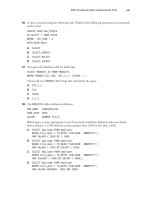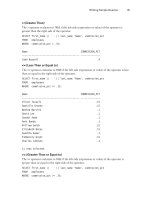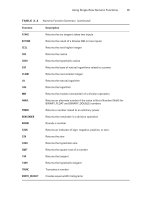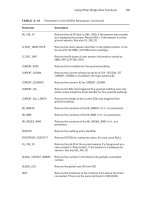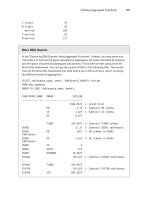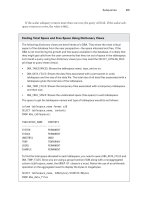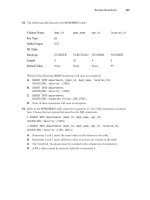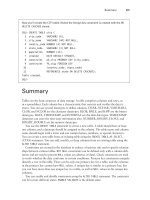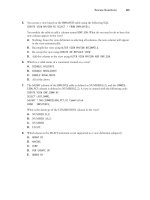OCA: Oracle® Database 12c Administrator Certified Associate II
Bạn đang xem bản rút gọn của tài liệu. Xem và tải ngay bản đầy đủ của tài liệu tại đây (8.43 MB, 770 trang )
OCP
Oracle Database 12c
Administrator Certified
Professional
®
Study Guide
Robert G. Freeman
Charles A. Pack
Senior Acquisitions Editor: Jeff Kellum
Development Editor: Tom Cirtin
Technical Editors: Pete Sharman; Syed Jaffar Hussain
Production Editor: Dassi Zeidel
Copy Editor: Linda Recktenwald
Editorial Manager: Pete Gaughan
Vice President and Executive Group Publisher: Richard Swadley
Associate Publisher: Chris Webb
Media Project Manager 1: Laura Moss-Hollister
Media Associate Producer: Doug Kuhn
Media Quality Assurance: Josh Frank
Book Designer: Judy Fung
Compositor: Craig Woods, Happenstance Type-O-Rama
Proofreader: Sara Wilson
Indexer: Ted Laux
Project Coordinator, Cover: Patrick Redmond
Cover Designer: Wiley
Cover Image: ©Getty Images Inc./Jeremy Woodhouse
Copyright © 2014 by John Wiley & Sons, Inc., Indianapolis, Indiana
Published simultaneously in Canada
ISBN: 978-1-118-64407-2
ISBN: 978-1-118-76331-5 (ebk)
ISBN: 978-1-118-93191-2 (ebk)
No part of this publication may be reproduced, stored in a retrieval system or transmitted in any form or
by any means, electronic, mechanical, photocopying, recording, scanning or otherwise, except as permitted under Sections 107 or 108 of the 1976 United States Copyright Act, without either the prior written
permission of the Publisher, or authorization through payment of the appropriate per-copy fee to the Copyright Clearance Center, 222 Rosewood Drive, Danvers, MA 01923, (978) 750-8400, fax (978) 646-8600.
Requests to the Publisher for permission should be addressed to the Permissions Department, John Wiley
& Sons, Inc., 111 River Street, Hoboken, NJ 07030, (201) 748-6011, fax (201) 748-6008, or online at
/>Limit of Liability/Disclaimer of Warranty: The publisher and the author make no representations or warranties with respect to the accuracy or completeness of the contents of this work and specifically disclaim
all warranties, including without limitation warranties of fitness for a particular purpose. No warranty
may be created or extended by sales or promotional materials. The advice and strategies contained herein
may not be suitable for every situation. This work is sold with the understanding that the publisher is not
engaged in rendering legal, accounting, or other professional services. If professional assistance is required,
the services of a competent professional person should be sought. Neither the publisher nor the author shall
be liable for damages arising herefrom. The fact that an organization or Web site is referred to in this work
as a citation and/or a potential source of further information does not mean that the author or the publisher
endorses the information the organization or Web site may provide or recommendations it may make. Further, readers should be aware that Internet Web sites listed in this work may have changed or disappeared
between when this work was written and when it is read.
For general information on our other products and services or to obtain technical support, please contact
our Customer Care Department within the U.S. at (877) 762-2974, outside the U.S. at (317) 572-3993 or
fax (317) 572-4002.
Wiley publishes in a variety of print and electronic formats and by print-on-demand. Some material
included with standard print versions of this book may not be included in e-books or in print-on-demand.
If this book refers to media such as a CD or DVD that is not included in the version you purchased, you
may download this material at . For more information about Wiley
products, visit www.wiley.com.
Library of Congress Control Number: 2014930409
TRADEMARKS: Wiley and the Sybex logo are trademarks or registered trademarks of John Wiley &
Sons, Inc. and/or its affiliates, in the United States and other countries, and may not be used without written permission. Oracle is a registered trademark of Oracle and/or its affiliates. All other trademarks are the
property of their respective owners. John Wiley & Sons, Inc. is not associated with any product or vendor
mentioned in this book.
10 9 8 7 6 5 4 3 2 1
Dear Reader,
Thank you for choosing OCP: Oracle Database 12c Administrator Certified Professional
Study Guide. This book is part of a family of premium-quality Sybex books, all of which are
written by outstanding authors who combine practical experience with a gift for teaching.
Sybex was founded in 1976. More than 30 years later, we’re still committed to producing consistently exceptional books. With each of our titles, we’re working hard to set a new standard
for the industry. From the paper we print on, to the authors we work with, our goal is to bring
you the best books available.
I hope you see all that reflected in these pages. I’d be very interested to hear your comments
and get your feedback on how we’re doing. Feel free to let me know what you think about this
or any other Sybex book by sending me an email at If you think you’ve
found a technical error in this book, please visit . Customer feedback is critical to our efforts at Sybex.
Best regards,
Chris Webb
Associate Publisher
Sybex, an Imprint of Wiley
For my Carrie, my kids, and my parents.
—Robert G. Freeman
For my wife, Donna, and our daughter, Jenny.
—Charles A. Pack
Acknowledgments
Writing a book is such a vast undertaking that it’s hard to know where to start with the
acknowledgments. I also hate writing this part because, frankly, someone always gets forgotten. That being said, here we go.
Thanks to my patient wife, Carrie, who sits across from me in the bedroom as I write
away. I’m sure she is tired of being a book/work widow. Thanks to my little bundle of joy,
Amy, who is now 8 months old. She and Carrie both remind me daily of what is truly important in the world. Thanks to my awesome older kids. It’s so odd to have an 8-month-old and
then five kids from ages 28 to 21. Thanks to all the folks at Oracle with whom I work, they
are way too many to name.
Writing books is a long, complex, and often frustrating task. Thanks to all the folks at
Sybex who participated in the making of this book. Thanks especially to Jeff Kellum, who
was my acquisitions editor, for getting me involved in this project. I’d worked with Jeff before
on my very first book, and apparently he didn’t remember the pain I caused him well enough,
since he asked me to write this book anyway. Jeff put up with a lot on this book; we really
made the schedule something of a joke, I’m afraid. Thanks to Tom Cirtin, who tried so hard
to get us back on track schedule-wise.
Finally, a very important thanks goes out to you. Thanks for buying this book. Thanks
for wanting to become an Oracle Certified Professional. Thanks for any nice comments you
might leave on websites here and there. Thanks for trusting us to help you succeed at the test!
—Robert G. Freeman
Thanks to Robert Freeman and Jeff Kellum for the opportunity to write this book. Thanks
to my colleagues at CSX, some of the brightest and hardest working people I’ve ever known,
for continuously challenging me to stay technically sharp.
This book would not have been written without my wife’s permission, of course. Thank
you, Donna, for your support through these fun projects of mine. Thank you to my daughter
Jenny, who is now 13 and is sitting next to me on the sofa sketching MLP characters on her
iPad while I write about “the Oracle.”
—Charles A. Pack
About the Authors
Robert G. Freeman lives in Las Vegas, Nevada, and loves it. He is a Master Principal
Database Expert at Oracle Corporation. He works in the Engineered Systems Group
(Public Sector) and deals with things like Exadata and Oracle databases all the time.
Besides working with Oracle databases (that’s his story and he’s sticking to it), Robert
writes an occasional book (at last count over a dozen), flies airplanes, enjoys karate, and
has a family that is awesome. He met Charles Pack, who is a fellow Okie (even if he sometimes roots for the wrong school), years ago and to this day wonders if Charles will ever
walk around without wearing sunglasses to hide his eyes and the deep meaning contained
in them. Robert is the husband of the patient Carrie and father of six (and counting!) wonderful, if not occasionally misguided, children.
Charles A. Pack is an Oracle Certified Professional DBA with over 25 years of IT experience. His career has included PC repairman, network administrator, systems operator,
COBOL programmer, backup and storage engineer, DBA, architect, project manager, and
people manager. He earned a bachelor of science degree from Oklahoma State University,
an MBA from The University of Oklahoma, and a master of science in computer science
from Texas A&M University—Corpus Christi. He has taught Oracle DBA classes at
Florida State College—Jacksonville and has presented on the subject at universities and
to professional organizations. He authored the Oracle Press OCP Oracle9i Database:
Performance Tuning Exam Guide and collaborated with co-author Robert Freeman on
Oracle 8 to 8i Upgrade Exam Cram.
At CSX Technology in Jacksonville, Florida, he has been responsible for storage, backups,
and capacity planning, as well as enterprise content management and collaboration. In his current role as Technical Director of Infrastructure Architecture, he and his teams are responsible
for strategic infrastructure design, capacity planning, and system performance. He is a true
cowboy at heart, and he loves to barbecue.
About the Technical Reviewers
Pete Sharman is a principal product manager with the Enterprise Manager product
suite group in the Server Technologies Division at Oracle Corporation. He has worked
with Oracle for the past 18 years in a variety of roles from education to consulting to
development and has used Enterprise Manager since its 0.76 beta release. Pete is a member of the Oak Table Network and has presented at conferences around the world from
Oracle Open World (both in Australia and the United States), RMOUG Training Days,
the Hotsos. He coauthored two books, one on Enterprise Manager 12c and another
on Oracle Database Appliance, and authored a book on how to pass the Oracle8i
Database Administration exam for the Oracle Certified Professional program. He lives
in Canberra, Australia, with his wife and three children.
Syed Jaffar Hussain has more than 21 years of IT experience that includes more than
14 years of production Oracle database administration. Oracle has honored him with the
prestigious Oracle ACE Director role and named him DBA of the Year for 2011, both
for his vast knowledge and for contributions to the Oracle community. He is an Oracle
Certified Master (OCM) for Oracle Database 10g, a status granted only after passing
extensive challenges in a hands-on environment. He is also an Oracle Database 10g RAC
Certified Expert. Syed Jaffar is a well-known Oracle speaker and he coauthored Expert
Oracle RAC12 and Oracle 11g R1/R2 Real Application Clusters Essentials. He blogs
regularly at .
Contents at a Glance
Introductionxxi
Assessment Test
xxxiii
Chapter 1
Performing Oracle User-Managed Backups
1
Chapter 2
Performing Oracle User-Managed Database Recoveries
Chapter 3
Configuring and Backing Up Oracle Databases
Using RMAN
105
Chapter 4
Using the RMAN Recovery Catalog
167
Chapter 5
Recovering Databases with RMAN
189
Chapter 6
Tuning and Monitoring RMAN and the Automatic
Diagnostic Workflow
239
Chapter 7
Performing Oracle Advanced Recovery
283
Chapter 8
Understanding Flashback Technology
349
Chapter 9
Diagnosing the Database and Managing Performance
399
Chapter 10
Managing Database Resources
455
Chapter 11
Creating Oracle Multitenant Databases
503
Chapter 12
Managing Oracle Multitenant Databases
551
Chapter 13
Oracle Utilities
585
Chapter 14
Oracle Security in CDBs and PDBs
623
Appendix A
Answers to Review Questions
661
Appendix B
About the Additional Study Tools
687
57
Index691
Contents
Introductionxxi
Assessment Test
Chapter 1
xxxiii
Performing Oracle User-Managed Backups
1
Oracle Database Data Protection Options
2
What Kind of Failures Can Happen to a Database
2
Physical and Logical Backups
3
Tools for Backup and Recovery
3
Oracle MAA Recommendations
4
Understanding the Oracle Database as It Relates to Backup and
Recovery5
Oracle Processes Related to Backup and Recovery
6
Oracle Memory Structures Related to Backup and Recovery 8
The Oracle Data Dictionary
8
Oracle Data Files and Tablespaces
11
Redo Logs
12
Control File
14
Parameter Files
15
NOARCHIVELOG and ARCHIVELOG Modes
17
The Oracle Instance and the Oracle Database
18
Configuring the Database for Backup and Recovery
26
Configuring for ARCHIVELOG Mode
26
Putting the Database in ARCHIVELOG Mode
29
Using ARCHIVELOG Mode Data Dictionary Views
33
Performing Oracle Offline Backups
36
Performing Oracle Online Backups
40
The Mechanics of Online Backups
40
Backing Up the Control File
46
Creating a Backup Control File
46
Creating a Trace File with the Create CONTROLFILE
Command in It
47
Summary49
Exam Essentials
50
Review Questions
51
Chapter 2
Performing Oracle User-Managed
Database Recoveries
57
Performing a Recovery in NOARCHIVELOG Mode
Performing a Full Database Recovery in ARCHIVELOG Mode
Preparing for the Recovery
Recovering the Database
58
62
62
64
xiiContents
Performing User-Based Incomplete Recoveries
77
Requirements for and Mechanics of an Incomplete Recovery 77
Preparing for an Incomplete Recovery
77
Performing an Incomplete Recovery
79
Performing Other Types of Recoveries
85
Recovering from the Loss of a Tempfile
85
Recovering from the Loss of an Online Redo Log Group
85
Recovering from the Loss of a Control File
89
Recovering from the Loss of the Password File
93
Recovering from the Loss of Everything
93
Summary94
Exam Essentials
95
Review Questions
96
Chapter 3
Configuring and Backing Up Oracle
Databases Using RMAN
105
Why Use RMAN?
107
Exploring the RMAN Architecture
108
Getting Started with RMAN
110
Starting the RMAN Interface
110
The SYSBACKUP Privilege
111
The RMAN Command Line
113
The RMAN Command Prompt
114
Calling SQL from the RMAN Command Prompt
114
Configuring RMAN
115
The Fast Recovery Area
116
RMAN Persistent Configuration Settings
119
Unique RMAN Configuration Settings
120
Preparing RMAN for Use
121
Backing Up Your Database with RMAN
136
Using the RMAN Command Line
136
Types of RMAN Backups
141
RMAN Offline Backups
145
RMAN Online Backups
145
RMAN Incremental Backups
151
RMAN Incrementally Updated Backups
154
RMAN Multisection Backups
155
RMAN Backup of Archived Redo Logs
156
RMAN Backup of the Spfile and Control Files
157
Backing Up RMAN Backup Sets
158
Backing Up the RMAN FRA
158
Creating Archival Backups
159
Summary159
Exam Essentials
160
Review Questions
161
Contents
Chapter 4
Using the RMAN Recovery Catalog
xiii
167
Introducing the Recovery Catalog
168
Creating the Recovery Catalog User and Schema Objects
170
Using a Recovery Catalog
172
Connecting to the Recovery Catalog from RMAN
173
Registering the Target Database with the Recovery Catalog 174
Unregistering a Database
174
Using Scripts in the RMAN Recovery Catalog
175
Executing External Scripts
175
Creating Stored Scripts
176
Using Script Substitution Variables
177
Maintaining the Recovery Catalog
177
Dropping the Recovery Catalog
178
Upgrading the Recovery Catalog
178
Synchronizing the Recovery Catalog
178
Export and Import the Recovery Catalog
178
Backing Up the Recovery Catalog
179
Recreating an Unrecoverable Recovery Catalog
179
Using the RMAN Virtual Private Catalog
181
Creating the RMAN Virtual Private Catalog
181
Administering the RMAN Virtual Private Catalog
182
Summary183
Exam Essentials
183
Review Questions
185
Chapter 5
Recovering Databases with RMAN
189
RMAN Database-Recovery Basics
191
Recovering a Database in NOARCHIVELOG Mode
192
Recovering a Database in ARCHIVELOG Mode
194
Complete Database Recovery in ARCHIVELOG Mode
195
Data File or Tablespace Recovery in
ARCHIVELOG Mode
200
Recovering a Database Using Incomplete Recovery
209
Types of Point-in-Time Recovery
209
Point-in-Time Recovery Mechanics
214
Using Image Copies to Recover Your Database
217
Other Basic Recovery Topics
218
Block Media Recovery
218
Recovering the Control File
219
Recovering the Spfile
224
Recovering the Database Password File
229
Clearing Redo Logs
229
Summary230
Exam Essentials
230
Review Questions
232
xivContents
Chapter 6
Tuning and Monitoring RMAN and the
Automatic Diagnostic Workflow
239
Overview of the RMAN Report and List Commands
240
Using the RMAN REPORT Command
240
Using the RMAN LIST Command247
Monitoring, Administering, and Tuning RMAN
256
Monitoring RMAN Operations
257
Administering RMAN Operations
260
Tuning RMAN Operations
263
The Oracle Database Fault Diagnostic Framework
264
Overview of the Oracle Database Fault
Diagnostic Framework
265
The Oracle ADR
267
Problems and Incidents
269
The Automatic Diagnostic Workflow—Managing
Problems and Incidents
270
Components Related to the Fault
Diagnosability Framework
271
Enterprise Manager Support Workbench
272
The ADRCI Command-Line Utility
273
Summary275
Exam Essentials
275
Review Questions
277
Chapter 7
Performing Oracle Advanced Recovery
Switching between RMAN Incarnations
Overview of RMAN Database Duplication
RMAN Database Duplication Basics
Performing an RMAN Database Duplication
Performing an RMAN Tablespace Point-in-Time Recovery
TSPITR Overview
Checking the Transport Set
Lost Objects
Rules, Rules, and More Rules
TSPITR Aftereffects
Restoring a Database to a New Host
Using RMAN to Move a Database
Oracle Data Pump, Oracle GoldenGate and
Oracle Data Guard
Complete Disaster
Backup Best Practices for Data Warehouses
The First Execution of the Command
The Second Execution of the Command
283
285
287
287
289
299
300
302
303
304
304
308
308
310
310
311
312
313
Contents
xv
The Third Execution of the Command
313
Restoring from Incrementally Updated Backups
315
Performing Table and Partition Recovery from Backups
315
Things to Check Before Trying to Restore and
Recover Database Tables and Partitions
316
Restrictions When Restoring and Recovering
Database Tables and Partitions
317
Options to Consider When Performing Table or
Table Partition Restores
317
An Example of Using RMAN to Restore and
Recover a Database Table
318
ASM-Related Backups
320
Quick ASM Overview
321
ASM Diskgroup Metadata Backups
321
Restoring ASM Disk Groups
323
Configuring and Using Oracle Secure Backup
323
What Is OSB?
324
How Does OSB Interface with RMAN?
325
The OSB Architecture
325
Installing and Configuring OSB
327
Oracle Database 12c Multitenant Architecture and RMAN
329
Architecture Overview
329
Backing Up CDBs with RMAN
330
Backing Up PDBs with RMAN
331
Recovering CDBs and PDBs with RMAN
332
Duplicating a PDB with RMAN
333
Oracle Data Pump and Oracle Multitenant
334
The Data Recovery Advisor
335
Summary339
Exam Essentials
340
Review Questions
341
Chapter 8
Understanding Flashback Technology
Describe the Flashback Technologies
Managing Undo Automatically
Uncovering Undo
Working with Automatic Undo Management
Preserving Data with Undo Retention
Employing Flashback Technologies
Recovering Tables and Objects with Flashback Drop
and the Recycle Bin
Use Flashback to Query Data
Recovering Data with Flashback Version Query
349
351
352
352
354
355
357
357
368
373
xviContents
Detecting Changes with Flashback Transaction Query
376
Perform Flashback Table Operations
379
Describe and Use Flashback Data Archive
383
Perform Flashback Database Operations
385
Summary390
Exam Essentials
391
Review Questions
392
Chapter 9
Diagnosing the Database and
Managing Performance
399
Diagnosing Failures
400
Setting Up the Automatic Diagnostic Repository
400
Using the Support Workbench
404
Performing Block Media Recovery
414
Managing Database Performance
416
Using the SQL Tuning Advisor
417
Using the SQL Access Advisor to Tune a Workload
424
Perform Database Replay
430
Summary448
Exam Essentials
449
Review Questions
450
Chapter 10
Managing Database Resources
455
Managing Storage
456
Managing Resumable Space Allocation
456
Managing Transportable Tablespaces
466
Managing Transportable Databases
479
Shrinking Segments
486
Managing Storage in a CDB and PDBs
494
Manage Permanent and Temporary Tablespaces in
CDB and PDBs
495
Summary497
Exam Essentials
497
Review Questions
498
Chapter 11
Creating Oracle Multitenant Databases
Multitenant Container and Pluggable Database Architecture
Describing the Multitenant Architecture
Explaining Pluggable Database Provisioning
Creating Multitenant Container Databases and
Pluggable Databases
Creating and Configuring a CDB
Creating a PDB Using Different Methods
503
504
504
507
508
508
517
Contents
xvii
Unplugging and Dropping a PDB
534
Migrating a Pre-12.1 Non-CDB Database to a CDB
542
Summary544
Exam Essentials
544
Review Questions
545
Chapter 12
Managing Oracle Multitenant Databases
551
Establishing Connections to CDB/PDB
552
User Accounts in a CDB
553
Establishing Connections to a CDB
554
Establishing Connections to a PDB
558
Start Up and Shut Down a CDB and Open and Close PDBs
564
Starting Up the CDB Using SQL*Plus
564
Shutting Down the CDB
567
Opening a PDB
570
Shutting Down or Closing a PDB
572
Evaluate the Impact of Parameter Value Changes
574
AUDIT_FILE_DEST574
AUDIT_ SYS_OPERATIONS575
AUDIT_ SYSLOG_LEVEL575
AUDIT_TRAIL575
ENABLE_PLUGGABLE_DATABASE576
LDAP_DIRECTORY_ACCESS576
MAX_ STRING_ SIZE576
NONCDB_COMPATIBLE576
PDB_FILE_NAME_CONVERT577
RESOURCE_MANAGER_PLAN577
SESSIONS577
Summary578
Exam Essentials
578
Review Questions
580
Chapter 13
Oracle Utilities
585
Moving Data, Performing Security Operations, and
Interacting with Other Oracle Products
586
Using Data Pump
587
Understanding and Using SQL*Loader
595
Audit Operations
603
Using Other Products with CDBs and PDBs—
Database Vault, Data Guard, LogMiner
606
Summary616
Exam Essentials
616
Review Questions
618
xviiiContents
Chapter 14
Oracle Security in CDBs and PDBs
623
Managing Security in a CDB and PDBs
624
Managing Common and Local Users
625
Managing Common and Local Privileges
636
Managing Common and Local Roles
642
Enabling Common Users to Access Data in Specific PDBs 648
Summary653
Exam Essentials
654
Review Questions
655
Appendix A
Answers to Review Questions
Chapter 1: Performing Oracle User-Managed Backups
Chapter 2: Performing Oracle User-Managed
Database Recoveries
Chapter 3: Configuring and Backing Up Oracle
Databases Using RMAN
Chapter 4: Using the RMAN Recovery Catalog
Chapter 5: Recovering Databases with RMAN
Chapter 6: Tuning and Monitoring RMAN and the
Automatic Diagnostic Workflow
Chapter 7: Performing Oracle Advanced Recovery
Chapter 8: Understanding Flashback Technology
Chapter 9: Diagnosing the Database and
Managing Performance
Chapter 10: Managing Database Resources
Chapter 11: Creating Oracle Multitenant Databases
Chapter 12: Managing Oracle Multitenant Databases
Chapter 13: Oracle Utilities
Chapter 14: Oracle Security in CDBs and PDBs
Appendix B
About the Additional Study Tools
661
662
664
666
668
669
671
672
674
676
678
680
681
682
684
687
Additional Study Tools
688
Sybex Test Engine
688
Electronic Flashcards
688
Bonus Lab Exercises
688
Glossary688
Adobe Reader
689
System Requirements
689
Using the Study Tools
689
Troubleshooting689
Customer Care
690
Index691
Table of Exercises
Exercise 1.1
Putting a Database in ARCHIVELOG Mode . . . . . . . . . . . . . . . . . . . . . . . . . 31
Exercise 1.2
Putting the V$ Views to Work . . . . . . . . . . . . . . . . . . . . . . . . . . . . . . . . . . . . 34
Exercise 1.3
Executing an Offline Backup . . . . . . . . . . . . . . . . . . . . . . . . . . . . . . . . . . . . 36
Exercise 1.4
Executing an Online Backup . . . . . . . . . . . . . . . . . . . . . . . . . . . . . . . . . . . . . 42
Exercise 2.1
Restoring a Database Using a Cold Backup . . . . . . . . . . . . . . . . . . . . . . . . 59
Exercise 2.2
Recovering the Database from the Loss of All Data Files . . . . . . . . . . . . . 67
Exercise 2.3
Performing a Point-in-Time Recovery . . . . . . . . . . . . . . . . . . . . . . . . . . . . . 81
Exercise 3.1
Configuring RMAN . . . . . . . . . . . . . . . . . . . . . . . . . . . . . . . . . . . . . . . . . . . 134
Exercise 3.2
Executing an Online Backup . . . . . . . . . . . . . . . . . . . . . . . . . . . . . . . . . . . . 148
Exercise 4.1
Creating a Recovery Catalog Schema . . . . . . . . . . . . . . . . . . . . . . . . . . . . . 171
Exercise 5.1
Restoring Your ARCHIVELOG-Mode Database with RMAN . . . . . . . . . . 197
Exercise 5.2
Perform a Point-in-Time Recovery with RMAN . . . . . . . . . . . . . . . . . . . . . 211
Exercise 6.1
Using the REPORT Command . . . . . . . . . . . . . . . . . . . . . . . . . . . . . . . . . . 245
Exercise 6.2
Using the LIST Command . . . . . . . . . . . . . . . . . . . . . . . . . . . . . . . . . . . . . . 253
Exercise 7.1
Duplicating a Database Using Backup-Based Duplication . . . . . . . . . . . 294
Exercise 7.2
Performing a Tablespace Point-in-Time Recovery . . . . . . . . . . . . . . . . . . 305
Exercise 8.1
Purging a Table from the Recycle Bin . . . . . . . . . . . . . . . . . . . . . . . . . . . . 364
Exercise 8.2
Using Flashback Query . . . . . . . . . . . . . . . . . . . . . . . . . . . . . . . . . . . . . . . . 371
Exercise 8.3
Using Flashback Table . . . . . . . . . . . . . . . . . . . . . . . . . . . . . . . . . . . . . . . . . 382
Exercise 9.1
Setting the Diagnostic Destination . . . . . . . . . . . . . . . . . . . . . . . . . . . . . . 402
Exercise 9.2
Using the ADRCI . . . . . . . . . . . . . . . . . . . . . . . . . . . . . . . . . . . . . . . . . . . . . . . 411
Exercise 9.3
Using the SQL Access Advisor . . . . . . . . . . . . . . . . . . . . . . . . . . . . . . . . . . 430
Exercise 9.4
Performing Database Replay . . . . . . . . . . . . . . . . . . . . . . . . . . . . . . . . . . . 448
Exercise 10.1
Exporting a Transportable Tablespace Set . . . . . . . . . . . . . . . . . . . . . . . . 475
Exercise 10.2
Shrinking a Segment . . . . . . . . . . . . . . . . . . . . . . . . . . . . . . . . . . . . . . . . . . 494
Exercise 11.1
Creating a New CDB Using SQL*Plus . . . . . . . . . . . . . . . . . . . . . . . . . . . . . 513
Exercise 11.2
Creating a PDB Using SQL*Plus . . . . . . . . . . . . . . . . . . . . . . . . . . . . . . . . . 524
Exercise 11.3
Using Data Pump to Migrate a Non-CDB into a PDB . . . . . . . . . . . . . . . . 543
Exercise 12.1
Connecting to a CDB Using SQL*Plus . . . . . . . . . . . . . . . . . . . . . . . . . . . . 555
Exercise 12.2
Connecting to a PDB Using SQL*Plus . . . . . . . . . . . . . . . . . . . . . . . . . . . . 559
Exercise 13.1
Using Data Pump to Migrate a Non-CDB into a PDB . . . . . . . . . . . . . . . . 590
Exercise 13.2
Plugging a Database Vault–Enabled PDB into a CDB . . . . . . . . . . . . . . . 607
Exercise 13.3
Steps for Using LogMiner . . . . . . . . . . . . . . . . . . . . . . . . . . . . . . . . . . . . . . 614
Exercise 14.1
Creating Common and Local Users . . . . . . . . . . . . . . . . . . . . . . . . . . . . . . 634
Introduction
There is high demand for professionals in the information technology (IT) industry, and
Oracle certifications are the hottest credentials in the database world. You have made the
right decision to pursue your Oracle certification because it will give you a distinct advantage
in this highly competitive market.
Many readers may already be familiar with Oracle and do not need an introduction
to Oracle databases. For those who aren’t familiar with the company, Oracle, founded in
1977, sold the first commercial relational database and is now the world’s leading database
company and second-largest independent software company, with revenues of more than
$37 billion, and is headquartered in Redwood City, California.
Oracle databases are the de facto standard for large Internet sites, mission-critical enterprise applications, and cloud solutions. With the acquisition of Sun Microsystems, Oracle
offers complete enterprise business solutions with engineered systems capable of running
world-class databases and applications. Enterprise Resource Planning (ERP) application
suites, data warehouses, and business applications at many large and medium-size companies rely on Oracle. The demand for DBA resources remains higher than for other professions during weak economic times.
This book is intended to help you pass the Oracle Database 12c: Advanced
Administration exam, which will establish your credentials as an Oracle Certified
Professional (OCP). The OCP certification is a prerequisite for obtaining an Oracle
Certified Master (OCM) certification. Using this book and a practice database, you
can learn the necessary skills to pass the 1Z0-063 Oracle Database 12c: Advanced
Administration exam.
Why Become Oracle Certified?
The number-one reason to become an OCP is to gain more visibility and greater access to
the industry’s most challenging opportunities. Oracle certification is the best way to demonstrate your knowledge and skills in Oracle database systems.
Certification is proof of your knowledge and shows that you have the skills required
to support Oracle core products. The Oracle certification program can help a company to
identify proven performers who have demonstrated their skills and who can support the
company’s investment in Oracle technology. It demonstrates that you have a solid understanding of your job role and the Oracle products used in that role.
OCPs are among the best paid in the IT industry. Salary surveys consistently show the
OCP certification to yield higher salaries than other certifications, including Microsoft,
Novell, and Cisco.
So whether you are beginning your career, changing your career, or looking to secure
your position as a DBA, this book is for you!
xxiiIntroduction
Oracle Certifications
Oracle certifications follow a track that is oriented toward a job role. The primary certification tracks are Database, Applications, Java, Enterprise Management, Virtualization, and
Operating Systems. Within each track, Oracle has a tiered certification program of OCA
and OCP. Only the Database track has OCM. The Database track is clearly for the database administrator job role.
For the latest certification information on all of Oracle certification paths,
please visit the Oracle website at />prod-plq-dad/db_pages.getpage?page_id=39&p_org_id=1001&lang=US.
The role of database administrator (DBA) has become a key to success in today’s highly
complex database systems. The best DBAs work behind the scenes but are in the spotlight
when critical issues arise. They plan, create, maintain, and ensure that the database is available for the business. They have tools to proactively monitor the database for performance
issues and to prevent unscheduled downtime. The DBA’s job requires broad understanding
of the architecture of Oracle database and expertise in solving problems.
Sybex has Oracle certification study guides for the Database track. In the following sections, I will introduce you to the different tiers in the Oracle Database 12c certification
track.
Oracle Database 12c Administrator Certified Associate
The Oracle Certified Associate (OCA) credential is the first step toward achieving the
Oracle Certified Professional (OCP) certification. OCA shows that you have the fundamental knowledge and skills to support an Oracle Database 12c database. This certification
requires you to pass two exams that demonstrate your Oracle basics:
■■
1Z0-061: Oracle Database 12c: SQL Fundamentals
■■
1Z0-062: Oracle Database 12c: Installation and Administration
If you have already passed any one of the following tests, you need not take the 1Z0-061
exam; you need to pass only 1Z0-062.
■■
1Z0-051: Oracle Database 11g: SQL Fundamentals I
■■
1Z0-047: Oracle Database SQL Expert
The 1Z0-061 exam can be taken at a testing location or from your home using the
Internet. The 1Z0-062 test is offered at a Pearson VUE facility.
To register for the test, visit Pearson VUE at .
Oracle Certifications
xxiii
Oracle Database 12c Administrator Certified Professional
The Oracle Certified Professional credential shows that you have the skill and technical
expertise to manage and implement enterprise databases. The OCP tier challenges you to
demonstrate your continuing experience and knowledge of Oracle technologies. The OCP
test will measure your knowledge in setting up and managing multitenant architecture
databases and in backup and recovery. The Oracle Database 12c Administrator Certified
Professional certification requires you to have the OCA certification as well as to pass the
following exam:
■■
1Z0-063: Oracle Database 12c: Advanced Administration
In addition, the OCP candidate must take one instructor-led Oracle University hands-on
requirement class.
You should verify the list of approved hands-on courses at the Oracle
education website at />
Oracle Database 12c Administrator Certified Master
The highest level of certification available in any track is the Oracle Certified Master. The
OCM certification credential shows that you have the highest level of expertise in an Oracle
product. To become a certified master, you must first achieve OCP status and then complete
two advanced instructor-led classes at an Oracle education facility. You must also pass a
hands-on examination at an Oracle education facility. At the time of writing this book, the
Oracle Database 12c: Certified Master exam has not been released.
More Information and Resources
You can find most current information about Oracle certification at http://education
.oracle.com/certification. You may be asked to choose your country of residence before
being directed to the site. Follow the links under Certifications to choose the track and
learn more.
Choose the Database track to view the different certification versions available. Choose
Oracle Database 12c Administrator Certified Associate, and then click on the test to know
more about the test contents, the objectives covered in the test, and the passing score and to
register for the test.
The Oracle documentation is available online at . Oracle
documentation contains a wealth of information, which can be used to supplement what
you learn from this book.

